Choosing a quilt for your bed can be daunting. What size should you go for? How do you know it will fit? What if you want to make your own quilt? Can you base it on the standard size of commercial quilts? What is a standard quilt size?
Standard quilt sizes are designed to fit the common sizes of mattresses. A quilt measuring 110” x 108” is big enough to cover a king size mattress. For a twin mattress, a quilt measuring 70” x 90” is adequate. Queen sized quilts can be used on double or twin mattresses for larger overhangs.
In this article, you’ll learn the different sizes of standard quilts. Find out how to measure your mattress for the quilt of your dreams.
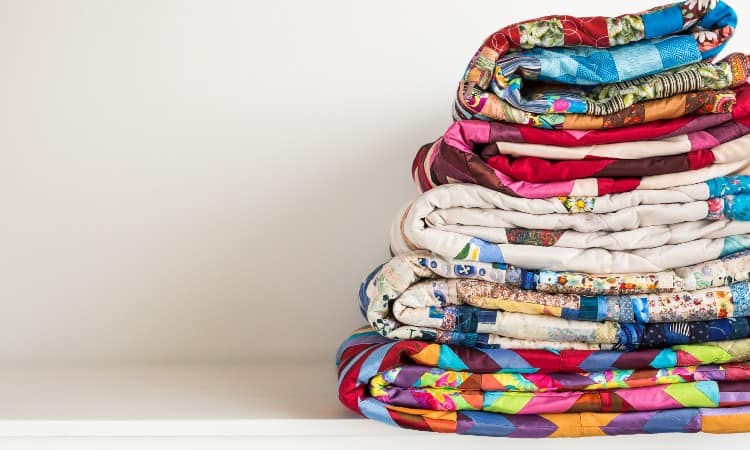
Quick Navigation
How to Measure a Bed for a Quilt
Measuring a bed for a quilt is relatively straightforward. You need to know your mattress’s length, width, and depth. These dimensions will give you an idea of the minimum size of quilt you’ll need.
Most commercial quilts are made to suit the different sizes of mattresses. You’ll find ready-made quilts for cribs, twins, queen, king, and even California king-sized beds. All you need are your mattress measurements and you can grab an off-the-shelf quilt to fit.
There are other factors to consider before choosing your quilt size. Your personal preference is top of the list. How do you like your quilt to look? Do you like a large overhang on each side, or do you prefer your quilt to skim the edges of your mattress?
Personal taste will alter the size you need to cover your bed. A larger overhang or drop will require a bigger quilt. You might find that to accomplish an opulent overhang on a full-size bed, you have to go for a queen-size quilt.
A pillow tuck will also increase the size of the quilt you need. Standard size quilts don’t normally allow for pillow tucks unless they are specifically styled that way. On average, you’re looking at adding an extra 10-20 inches to the length of your mattress to allow ample material to tuck under your pillows.
To make your own quilt, you need to allow for the quilt shrink factor. This is where your quilting stitches pull the quilt inwards as you stitch. You can lose from 1-3 inches all around just because of decorative needlework.
Because of this, homemade quilts need to be at least 3 inches bigger than you need. Particularly if the quilting design is intricate. Although, if the design is incredibly intricate, I’d aim for 5 inches bigger just to be safe. You can always trim the quilt down once you’ve finished stitching.
Standard Quilt Sizes
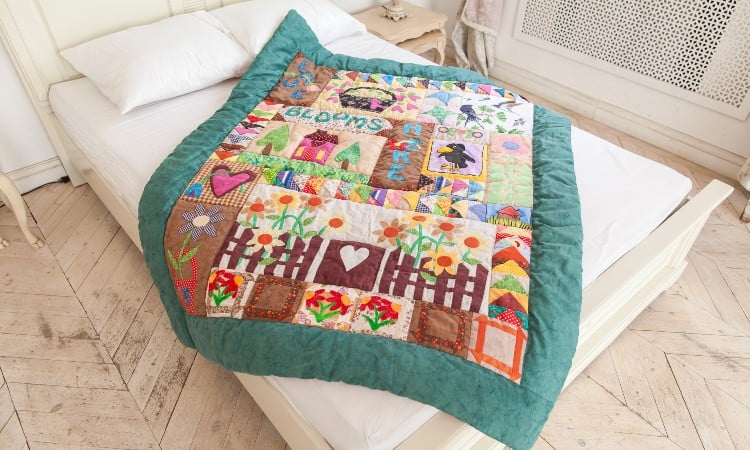
Commercial quilts are sold in a variety of sizes. These sizes have been designed to fit the mattresses available today. Standardized sizing allows for mass production and an assurance that a twin sized mattress will fit on a twin bed.
There is some wiggle room on quilt sizes. A crib mattress can measure 36 x 54 inches, but the size of the quilt to fit isn’t always the same. Crib quilts can have a width between 36-45 inches and a length of 45-54 inches.
As you can see, the range can vary. Not just for crib quilts but across the whole plethora of bed sizes. Because of this, it can be tricky to determine what quilt is best for your bed.
If you add homemade quilts into the equation, it can get even more complicated. Homemade quilts can be any size and shape. They can be extra large to allow for a pillow tuck or super small to skim the surface of a bed. It depends on the maker and the look they are trying to achieve.
In the following table, you’ll see a list of the standard mattress sizes alongside the quilt size best suited for that particular mattress. These figures are a guideline and will help you calculate how large or small your quilt needs to be. Where possible, they span the range from the smallest width to the largest length for each bed option.
| Quilt | Mattress Size | Quilt Size |
| Crib | 27” x 52” | 36” x 54” |
| Twin | 39” x 75” | 70” x 90” |
| Full/Double | 54” x 75” | 85” x 108” |
| Queen | 60” x 80” | 90” x 108” |
| King | 76’ x 84’ | 110” x 108” |
| California King | 72” x 84” | 106”x 108” |
Do Standard Quilt Sizes Include a Pillow Tuck?
Standard quilt sizes don’t normally include an allowance for a pillow tuck. They are usually just big enough to cover the bed to the pillow area with an overhang on three sides.
A pillow tuck is where your quilt covers the whole bed with enough to push under your pillows. This is usually adequate to allow for a 10-inch tuck. Then, the remaining top end of the quilt is folded over to cover the pillow area. Providing a neat finish to your bed and a touch of elegance to your bedroom.
Whether your quilt includes a pillow tuck or not depends on the style. Not only are there different sizes of quilts to suit the various sizes of mattresses available, but there are also three different styles of quilts. The comforter, the coverlet, and the bedspread.
The comforter is probably the one we are all the most familiar with. This is the one that covers the bed from the pillow area down. It has an overhang on the bottom and two sides of around 12-15 inches. It’s usually the comforter that springs to mind when you think of a standard quilt size.
A coverlet is slightly different. Although it can be the same size as a comforter, it is much lighter. While a comforter is filled with some form of fluffy batting, a coverlet can be flat and thin. Sometimes, it can be two layers of cotton quilted together without filling.
Coverlets add a hint of sophistication to your bed. This is the style of quilt you’ll find draped across the foot of the bed for decoration. They can be longer and wider than a comforter and have an extra allowance of around 10 inches for a pillow tuck.
The last style of quilt is the bedspread. A bedspread spreads all over the bed. Large enough for a decent overhang that can skim the floor, it also has enough length to provide a pillow tuck. Expensive bedspreads can offer a decent-sized tuck under your pillow of up to 20 inches.
Pillow tucks aren’t for everyone. They can increase the time it takes to make your bed. You have to make an effort to form the tuck. A comforter is more of an easy-care style of bedding. You simply throw it over your bed and go.
Because of this, standard size quilts tend to be comforters. If you would like a pillow tuck, you’ll need to check the size of the comforter before you purchase it. You might need to buy one larger than your actual bed. To be confident you’ll get a pillow tuck of a suitable size, look for a bedspread.
What Is a Good Size for a Lap Quilt?
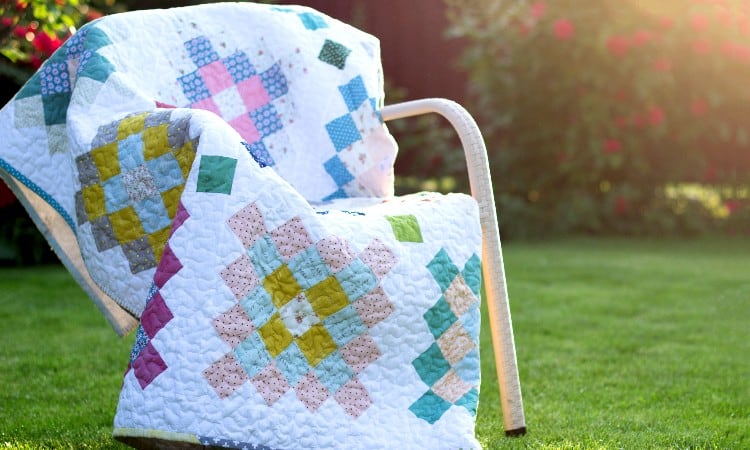
A good size for a lap quilt fits your lap and covers your lower body. They are designed to keep you warm while you are sitting. So it’s important that they cover the parts of your body most likely to get cold.
When you’re sitting, it’s your legs that get chilly. You can always put an extra sweater on if your top half is feeling an icy draft. But it’s not easy to throw on an extra pair of pants.
You can use a lap quilt anywhere. This can be on the couch watching TV or outside at a football game, sitting on the bleachers.
Lap quilts can be any size and shape. They can range from 30 x 72 inches to every size in between. The larger ones are ideal for people with longer legs or covering more than one person. While smaller lap quilts are perfect for use on wheelchairs or as a portable quilt for an outdoor picnic in the fall.
Most lap quilts tend to be 45 x 45 inches. This square shape has universal appeal. It can be used for any occasion you can use a lap quilt. Not only that, but these dimensions can accommodate laps of various sizes.
There isn’t a standard size for lap quilts. Their size and shape are determined by the user. As we are all different sizes, lap quilts have to be available in various proportions. As long as your lap quilt keeps you warm from the top of your hips to the tip of your toes, then it’s a good size for you.
Can I Make a Custom Sized Quilt?
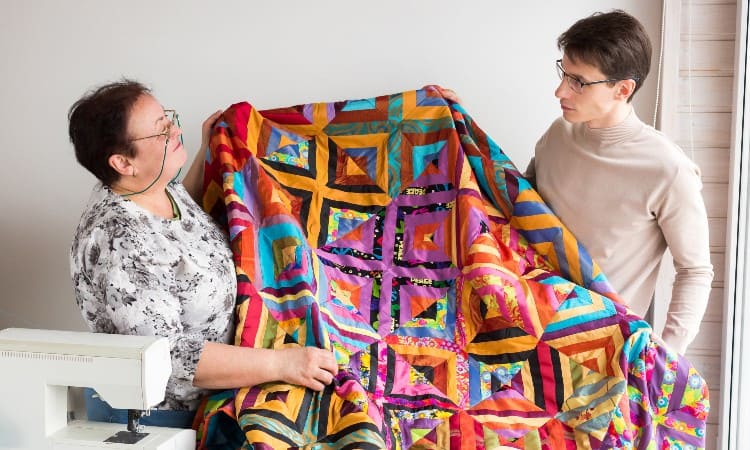
Yes, you can make a custom sized quilt. That’s one of the attractions of making your own. You can make it any size and shape you want.
Just because commercial quilts are within a specific size range doesn’t mean you have to stick to those measurements. Commercially produced quilts have to suit the masses, so they tend to be made into a one-size-fits-all formula.
The truth is one size rarely ever fits all. We’re all individual and have different tastes when it comes to the dimensions of our quilts. You might prefer a longer drop on the sides of your comforter, so it brushes the floor. It’s hard to find a commercial quilt that can do that without being too big in other areas.
Sticking with standard quilt sizes could lead to you compromising on your bedroom décor. Instead of the room of your dreams, you have to settle for as near as possible. A custom sized quilt allows you to embrace your creativity and bring those dreams to life.
Making your own quilt can ensure you get a perfect fit for your bed. You can tailor the measurements of the finished product to allow for those decorative extras like pillow tucks.
Better still, if you have a modern mattress with a large depth, you can customize the size of your quilt to cover it. Mattresses today can range from a depth of 7 inches through to 22 inches. Many commercial quilts only offer coverage for a depth of around 15 inches.
The best thing about a custom sized quilt is the design. It won’t look anything like the quilts you can buy ready-made. Not only will it fit your bed the way you want it to, but it can also showcase your personality.
What Size Quilt Do I Need for a Queen Bed?
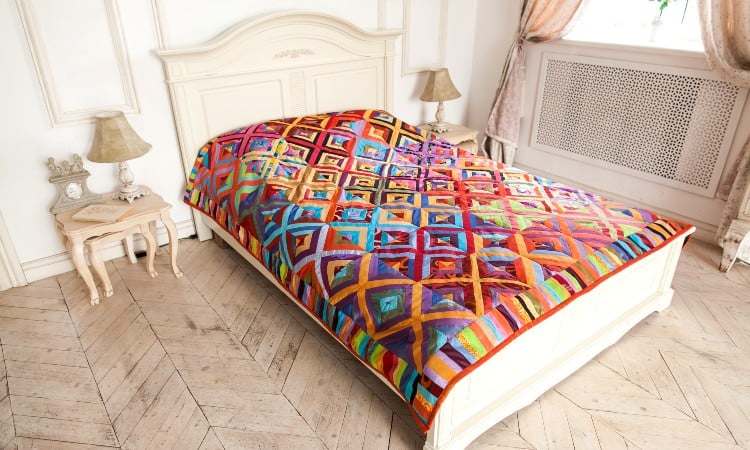
The size of quilt you need for your queen-sized bed depends on how you want your bed to look. It will also be determined by the depth of your mattress.
A standard queen sized bed usually has a mattress measuring 60 x 80 inches. This is the surface area, though, not the full size of your mattress.
If you go for a quilt measuring 60 x 80 inches, it will reach the edges of the mattress but not have any overhang. Nor will it have any allowance for a pillow tuck.
When measuring your mattress, you need to take three measurements. Width, length, and depth. This will give a more 3-D image of your mattress and enable you to get a better fitting quilt. You’ll also want to consider your preferred aesthetics. Do you want your quilt to cover your mattress or reach the floor?
For a floor-skimming look, you’ll need to measure from the top of your mattress down to the floor. It should fall about ½ inch shy of the floor surface. For a quilt to cover the top and sides of your mattress, you should measure the depth of your mattress but don’t include the bed base or frame.
To help put this into perspective, let’s take a look at an example. We’ll work with the standard queen sized mattress of 60 x 80 inches with a depth of 15 inches.
Your mattress has depth on both sides, the top and the bottom. This is important for you to remember. The first calculation we are going to deal with is the total width.
Take the surface width of 60 inches and add the depth. There are two sides which means you need to multiply 15 inches by 2. This gives you an extra 30 inches. Add this to the surface width to give you a total width of 90 inches. Your math should look like this: 60 + (15 x 2) = 90.
Next, we need the total length of the quilt. The length of the mattress is 80 inches. There is a top and a bottom to consider. The depth at each end of your mattress is 15 inches.
At this point, you need to decide how you want your quilt to look. Do you want it to stop at your pillows? Or cover them with a pillow tuck?
For a quilt that stops at the pillows, you only need to add an extra 15 inches to the length. This is because you don’t necessarily need an overhang at the top of the bed. The math for this situation is: 80 + 15 = 95 inches.
In this example, the quilt you need for a queen size bed would be 90 x 95 inches. But what if you do want the quilt to cover the pillows and have a pillow tuck?
This time you need to add an allowance for the tuck and the overhang at the top of the bed. The overhang is an extra 15 inches. A pillow tuck adds an extra 10 inches. The math has changed slightly and now looks like this: (80 + 10)+(15 x 2) = 120 inches.
Now the quilt you need for your queen size bed should measure 90 x 120 inches. If you wish the quilt reaches the floor, adjust the depth measurements accordingly.
These measurements are only an estimate. Your actual mattress and bed base may have different dimensions. As a rule of thumb, even if you have a queen size mattress, always measure it before choosing a quilt.
How Much Should a Quilt Overhang?
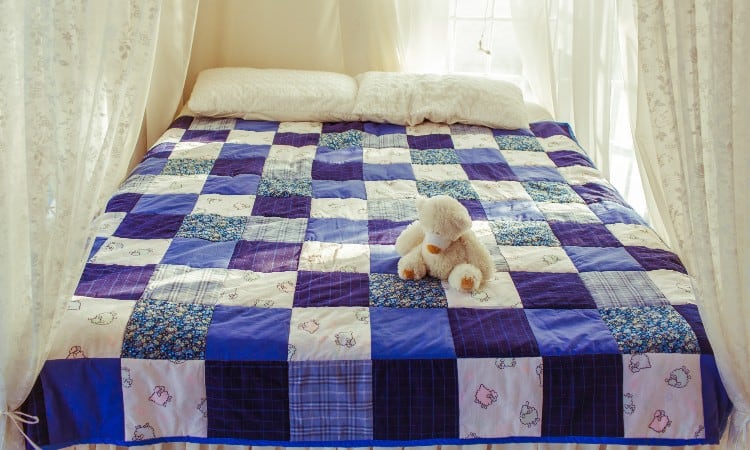
Traditionally, a quilt should have an overhang large enough to hide your mattress. However, nothing is set in stone. These days things are more fluid. You can have an overhang to reach the floor if you want. Or none at all.
How much of an overhang you go for depends on how you see quilts and what role you want them to perform. They do more than just keep you warm. A quilt can also add a certain cohesion to the overall aesthetics of your bedroom. It’s like the icing on a cake hiding all the bumpy, rough bits in the sponge below.
A quilt overhang, otherwise known as its drop, covers your blankets and sheets, which may or may not match. Your quilt hides your mattress and the join where the mattress and bed base meet. Not only that, but if you go for a floor-skimming quilt, it can also hide the dust and clutter underneath your bed!
If you’ve purchased new high-quality sheets and don’t want to hide them away, then don’t have an overhang on your quilt. You don’t have to. Your quilt can skim the surface of your bed and allow the sheets to shine. This is particularly pleasing when the sheets and quilt are part of a coordinating set.
Having a ruffle around the base of your bed will also help you determine your quilt’s drop. As the ruffle already hides the bed base, your quilt only needs to drop far enough to cover where the ruffle attaches to the bed.
At the end of the day, the drop on your quilt is up to you. There is no right or wrong way to dress your bed with a quilt. It’s down to personal preference and how you want your bed and bedroom to look.
Conclusion
Standard size quilts take the guesswork of choosing the right one for your bed. The packaging for each one will state what size bed it is for. Or, you can make your own quilt using the standard sizes.
Measure your mattress and decide how you want it to look. It is that simple to get a quilt that fits your bed perfectly.
Let me know in the comments if you liked the article. Have you bought a standard quilt size? Did you make your own? How did you get on?